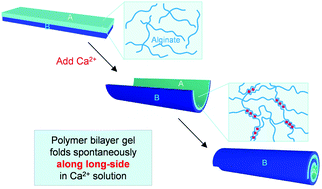当前位置:
X-MOL 学术
›
Soft Matter
›
论文详情
Our official English website, www.x-mol.net, welcomes your
feedback! (Note: you will need to create a separate account there.)
Cation-induced folding of alginate-bearing bilayer gels: an unusual example of spontaneous folding along the long axis
Soft Matter ( IF 2.9 ) Pub Date : 2018-03-22 00:00:00 , DOI: 10.1039/c8sm00321a Jasmin C. Athas 1, 2, 3, 4 , Catherine P. Nguyen 2, 3, 4, 5 , Shailaa Kummar 2, 3, 4, 5, 6 , Srinivasa R. Raghavan 1, 2, 3, 4, 5
Soft Matter ( IF 2.9 ) Pub Date : 2018-03-22 00:00:00 , DOI: 10.1039/c8sm00321a Jasmin C. Athas 1, 2, 3, 4 , Catherine P. Nguyen 2, 3, 4, 5 , Shailaa Kummar 2, 3, 4, 5, 6 , Srinivasa R. Raghavan 1, 2, 3, 4, 5
Affiliation

|
The spontaneous folding of flat gel films into tubes is an interesting example of self-assembly. Typically, a rectangular film folds along its short axis when forming a tube; folding along the long axis has been seen only in rare instances when the film is constrained. Here, we report a case where the same free-swelling gel film folds along either its long or short axis depending on the concentration of a solute. Our gels are sandwiches (bilayers) of two layers: a passive layer of cross-linked N,N′-dimethylyacrylamide (DMAA) and an active layer of cross-linked DMAA that also contains chains of the biopolymer alginate. Multivalent cations like Ca2+ and Cu2+ induce these bilayer gels to fold into tubes. The folding occurs instantly when a flat film of the gel is introduced into a solution of these cations. The likely cause for folding is that the active layer stiffens and shrinks (because the alginate chains in it get cross-linked by the cations) whereas the passive layer is unaffected. The resulting mismatch in swelling degree between the two layers creates internal stresses that drive folding. Cations that are incapable of cross-linking alginate, such as Na+ and Mg2+, do not induce gel folding. Moreover, the striking aspect is the direction of folding. When the Ca2+ concentration is high (100 mM or higher), the gels fold along their long axis, whereas when the Ca2+ concentration is low (40 to 80 mM), the gels fold along their short axis. We hypothesize that the folding axis is dictated by the inhomogeneous nature of alginate-cation cross-linking, i.e., that the edges get cross-linked before the faces of the gel. At high Ca2+ concentration, the stiffer edges constrain the folding; in turn, the gel folds such that the longer edges are deformed less, which explains the folding along the long axis. At low Ca2+ concentration, the edges and the faces of the gel are more similar in their degree of cross-linking; therefore, the gel folds along its short axis. An analogy can be made to natural structures (such as leaves and seed pods) where stiff elements provide the directionality for folding.
中文翻译:

阳离子诱导的带有藻酸盐的双层凝胶的折叠:长轴自发折叠的不寻常例子
扁平凝胶薄膜自发折叠成管子是自组装的一个有趣例子。通常,在形成管子时,矩形薄膜会沿其短轴折叠。只有在胶片受约束的极少数情况下,才可以看到沿长轴的折叠。在这里,我们报告了一种情况,其中相同的自由膨胀凝胶膜根据溶质的浓度沿其长轴或短轴折叠。我们的凝胶是两层的三明治(双层):交联的N,N'-二甲基丙烯酰胺(DMAA)的钝化层和交联的DMAA的活性层,其中也包含生物聚合物藻酸盐的链。Ca 2+和Cu 2+等多价阳离子诱导这些双层凝胶折叠成试管。当将凝胶的平膜引入这些阳离子的溶液中时,立即发生折叠。折叠的可能原因是活性层变硬和收缩(因为其中的藻酸盐链被阳离子交联),而钝化层则不受影响。导致的两层之间的溶胀度不匹配会产生内部应力,从而驱动折叠。不能交联藻酸盐的阳离子(例如Na +和Mg 2+)不会引起凝胶折叠。而且,醒目的方面是折叠的方向。当Ca 2+浓度较高(100 mM或更高)时,凝胶沿其长轴折叠,而当Ca 2+浓度低(40至80 mM)时,凝胶沿其短轴折叠。我们假设折叠轴是由藻酸盐阳离子交联的不均匀性质决定的,即,边缘在凝胶表面之前发生交联。在高Ca 2+浓度下,较硬的边缘会限制折叠。依次地,凝胶折叠使得较长的边缘变形较小,这解释了沿长轴的折叠。在低的Ca 2+浓度下,凝胶的边缘和表面的交联度更相似。因此,凝胶沿其短轴折叠。可以对自然结构(例如树叶和种子荚)进行类比,其中刚性元素为折叠提供了方向性。
更新日期:2018-03-22
中文翻译:

阳离子诱导的带有藻酸盐的双层凝胶的折叠:长轴自发折叠的不寻常例子
扁平凝胶薄膜自发折叠成管子是自组装的一个有趣例子。通常,在形成管子时,矩形薄膜会沿其短轴折叠。只有在胶片受约束的极少数情况下,才可以看到沿长轴的折叠。在这里,我们报告了一种情况,其中相同的自由膨胀凝胶膜根据溶质的浓度沿其长轴或短轴折叠。我们的凝胶是两层的三明治(双层):交联的N,N'-二甲基丙烯酰胺(DMAA)的钝化层和交联的DMAA的活性层,其中也包含生物聚合物藻酸盐的链。Ca 2+和Cu 2+等多价阳离子诱导这些双层凝胶折叠成试管。当将凝胶的平膜引入这些阳离子的溶液中时,立即发生折叠。折叠的可能原因是活性层变硬和收缩(因为其中的藻酸盐链被阳离子交联),而钝化层则不受影响。导致的两层之间的溶胀度不匹配会产生内部应力,从而驱动折叠。不能交联藻酸盐的阳离子(例如Na +和Mg 2+)不会引起凝胶折叠。而且,醒目的方面是折叠的方向。当Ca 2+浓度较高(100 mM或更高)时,凝胶沿其长轴折叠,而当Ca 2+浓度低(40至80 mM)时,凝胶沿其短轴折叠。我们假设折叠轴是由藻酸盐阳离子交联的不均匀性质决定的,即,边缘在凝胶表面之前发生交联。在高Ca 2+浓度下,较硬的边缘会限制折叠。依次地,凝胶折叠使得较长的边缘变形较小,这解释了沿长轴的折叠。在低的Ca 2+浓度下,凝胶的边缘和表面的交联度更相似。因此,凝胶沿其短轴折叠。可以对自然结构(例如树叶和种子荚)进行类比,其中刚性元素为折叠提供了方向性。











































 京公网安备 11010802027423号
京公网安备 11010802027423号